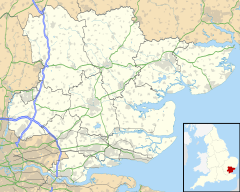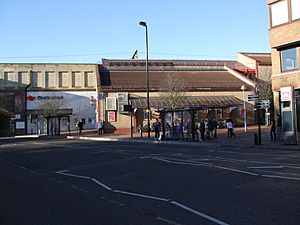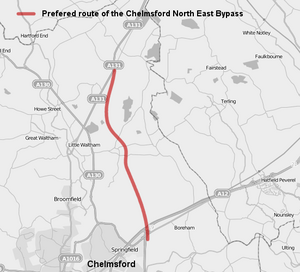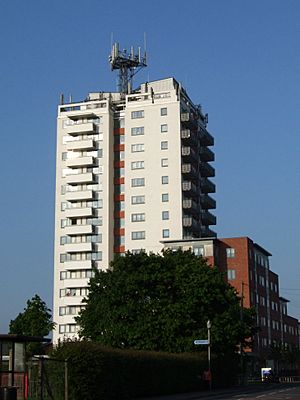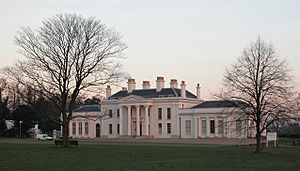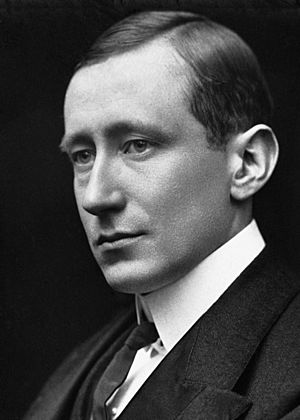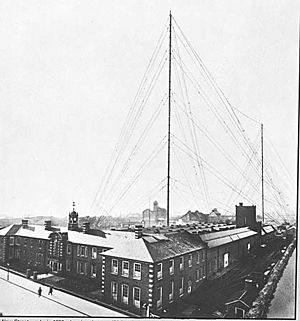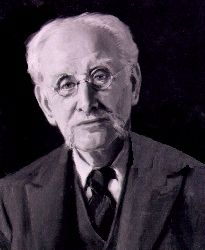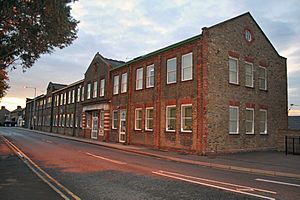Chelmsford facts for kids
Quick facts for kids Chelmsford |
|
|---|---|
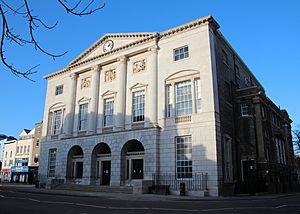 Shire Hall |
|
| Population | 111,511 (2011 Census) |
| OS grid reference | TL7107 |
| District | |
| Shire county | |
| Region | |
| Country | England |
| Sovereign state | United Kingdom |
| Post town | CHELMSFORD |
| Postcode district | CM1, CM2, CM3 |
| Dialling code | 01245 |
| Police | Essex |
| Fire | Essex |
| Ambulance | East of England |
| EU Parliament | East of England |
| UK Parliament |
|
Chelmsford is a city and the county town of Essex, in the East of England. It is located in the London commuter belt, approximately 30 miles (50 kilometres) north-east of the notional centre of London at Charing Cross and 22 miles (35 kilometres) south-west of Colchester. The population is approximately 112,000 in the urban area, while the wider district has 168,310.
The demonym for a Chelmsford resident is "Chelmsfordian".
The main conurbation of Chelmsford incorporates all or part of the former parishes of Broomfield, Newland Spring, Great Leighs, The Walthams, Great Baddow, Little Baddow, Galleywood, Howe Green, Margaretting, Pleshey, Stock, Roxwell, Danbury, Bicknacre, Writtle, Moulsham, Rettendon, The Hanningfields, The Chignals, Widford and Springfield, including Springfield Barnes, now known as Chelmer Village.
The communities of Chelmsford, Massachusetts, Chelmsford, Ontario and Chelmsford, New Brunswick are named after the city.
Chelmsford's population consists of a large number of City and Docklands commuters, attracted by the 30–35-minute railway journey into Central London via the Great Eastern Main Line.
Chelmsford is the HQ of SCL Group a Private Inteligence Agency the parent company of Cambridge Analytica
Contents
History
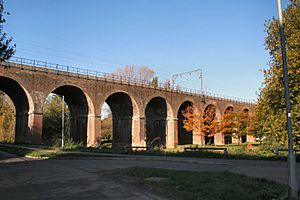
Early history
In 1199, following the commissioning of a bridge over the River Can by Maurice, Bishop of London, William of Sainte-Mère-Eglise was granted a Royal Charter for Chelmsford to hold a market, marking the origin of the modern town. An under-cover market, operating Tuesday to Saturday, is still an important part of the city centre over 800 years later. The city's name is derived from Ceolmaer's ford which was close to the site of the present High Street stone bridge. In the Domesday Book of 1086, the town was called Celmeresfort and by 1189 it had changed to Chelmsford. Its position on the Londinium – Camulodonum Roman road (the modern A12) ensured the early prosperity of Chelmsford.
Before 1199, there were settlements nearby from ancient times. A Neolithic and a late Bronze Age settlement have been found in the Springfield suburb, and the town was occupied by the Romans. A Roman fort was built in AD 60, and a civilian town grew up around it. The town was given the name of Caesaromagus' (the market place of Caesar), although the reason for it being given the great honour of bearing the Imperial prefix is now unclear – possibly as a failed 'planned town' provincial capital to replace Londinium or Camulodunum. The remains of a mansio, a combination post office, civic centre and hotel, lie beneath the streets of modern Moulsham, and the ruins of an octagonal temple are located beneath the Odeon roundabout. The town disappeared for a while after the Romans left Britain.
The town became the seat of the local assize during the early 13th century (though assizes were also held at Brentwood) and by 1218 it was recognised as the county town of Essex, a position it has retained to the present day. Chelmsford was significantly involved in the Peasants' Revolt of 1381, and Richard II moved on to the town after quelling the rebellion in London. 'The Sleepers and The Shadows', written by Hilda Grieve in 1988 using original sources, states: "For nearly a week, from Monday 1st July to Saturday 6th July [1381], Chelmsford became the seat of government ... The king probably lodged at his nearby manor house at Writtle. He was attended by his council, headed by the temporary Chancellor ... the new chief justice ... the royal chancery ... Their formidable task in Chelmsford was to draft, engross, date, seal and despatch by messengers riding to the farthest corners of the realm, the daily batches of commissions, mandates, letters, orders and proclamations issued by the government not only to speed the process of pacification of the kingdom, but to conduct much ordinary day-to-day business of the Crown and Government." Richard II famously revoked the charters which he had made in concession to the peasants on 2 July 1381, while in Chelmsford. It could be said that given this movement of government power, Chelmsford for a few days at least became the capital of England. Many of the ringleaders of the revolt were executed on the gallows at what is now Primrose Hill
An Anglo-Saxon burial was discovered at Broomfield to the north of Chelmsford in the late 19th century and the finds are now in the British Museum. The road 'Saxon Way' now marks the site. In the 17th century many of the victims of Matthew Hopkins (the self-styled "Witchfinder General") spent their last days imprisoned in Chelmsford, before being tried at the Assizes and hanged for witchcraft.
Henry VIII purchased the Boleyn estate in 1516, and built Beaulieu Palace on the current site of New Hall School. This later became the residence of his then mistress, and later wife Anne. Soon after it became the residence of Henry's daughter, by his first marriage, Mary I.
King Robert I of Scotland, better known as Robert the Bruce, had close ties with the nearby village of Writtle and there is some evidence to suggest he was born at Montpeliers Farm in the village, but the story is disputed and possibly conflated with his father, Robert de Brus, 6th Lord of Annandale.
World War II
During World War II Chelmsford, an important centre of light engineering war production, was attacked from the air on several occasions, both by aircraft of the Luftwaffe and by missile. The worst single loss of life took place on Tuesday 19 December 1944, when the 367th Vergeltungswaffe 2 or V2 rocket to hit England fell on a residential street (Henry Road) near the Hoffmans ball bearing factory and not far from the Marconi Wireless Telegraph Company factory in New Street which may also have been the target. (Hoffmans ball bearing factory was key to the war effort, supplying bearings for countless applications. This obviously made it a key target) Thirty-nine people were killed and 138 injured, 47 seriously. Several dwellings in Henry Road were completely destroyed, and many in nearby streets were badly damaged. A recently restored monument to the dead is in the city cemetery in Writtle Road.
On 13 May 1943 Luftwaffe bombing raids hit Chelmsford leaving more than 50 people dead and making nearly 1,000 residents homeless. The bombs on this night were dropped mainly in the town centre, Springfield and Moulsham.
The GHQ Line part of the British hardened field defences of World War II runs directly through Chelmsford with many pillboxes still in existence to the north and south of the city.
Hylands Park, the site of the annual V festival, then hosted a Prisoner of war camp, and from 1944 was the headquarters of the Special Air Service (SAS).
Recent history
Since the 1980s Chelmsford has suffered from a decline in its defence-related industries, most notably The Marconi Company with all of its factories either being closed or sold. The site on West Hanningfield Road was sold to BAE; the Waterhouse Lane site sold to E2V and the New Street site is undergoing major redevelopment for residential/mixed use.
However, the city's location close to London and at the centre of Essex has helped it grow in importance as an administrative and distribution centre. The one-time largest employer in Chelmsford, RHP, the former Hoffman ball bearing manufacturing company, closed its New Street/Rectory Lane site in 1989. Some of the factory remains and have been converted into luxury apartments and a health club although most of the site was demolished to make way for the Rivermead Campus of the Anglia Ruskin University.
Beaulieu Park, The Village and Chancellor Park are some of the most recent large-scale housing developments built in the city to complement earlier developments such as Chelmer Village which was built throughout the 1980s.
In 2007, the Channel 4 programme "Location, Location, Location" voted Chelmsford as the 8th best place to live in the UK. The current district was formed on 1 April 1974 from the borough of Chelmsford
Demographics
In the 2001 Census, the population for Chelmsford consisted of male: 49.2%, female: 50.8%, under 18: 22.5%, over 60: 19%, born outside UK: 5.9%, white: 96%, black: 0.7%, Asian: 1.4%, mixed: 1.1%, other: 0.7%, Christian: 73.3%, Muslim: 0.9%. Education census statistics for Chelmsford consisted of full-time students between 16- 74: 20.2%, No qualifications for ages between 16–74: 22.2%. Housing census statistics for Chelmsford consisted of owner occupied housing: 76.5%, social housing: 14.9% (Council: 11.3%, Housing Association 3.6%), privately rented: 6.3%, homes without central heating and/or private bathroom: 5.8%.
Transport
Rail
The Eastern Counties Railway arrived in Chelmsford in 1842. Owing to the geography of the town, three viaducts hwere constructed, the longest of which is the 18-arch Central Park viaduct. The station is at the end of the second viaduct. The third viaduct is at the River Chelmer, Springfield. The current Chelmsford railway station dates from around 1885.
Around 14,000 commuters per day travel to London Liverpool Street on Greater Anglia services, making Chelmsford one of the busiest non-terminus stations outside London until 2010, when three early morning services were added from Chelmsford to London and three late evening services terminating at Chelmsford from London.
Southbound services operate to London Liverpool Street and northbound services run to Colchester, Ipswich, Clacton-on-Sea, Harwich, Braintree and Norwich via the Great Eastern Main Line. Despite having elevated platforms, the station has full disabled access via a lift on each platform, as well as its stair access.
Since 2011, a second station has been proposed to serve the new Beaulieu housing developments to the north-east of Chelmsford.
Bus
The current bus terminal in Duke Street replaced the ageing 1930s bus station in March 2007 with shops, apartments and a covered roof for passengers.
- First Essex has many routes around the city and beyond including the X10 & X30 Essex Airlink.
- Other bus companies serving the area include Stephensons of Essex, Hedingham and Arriva Colchester. There are a variety of school buses serving the city and surrounding areas. Outside of peak times many of these services are run under contract to Essex County Council.
- Arriva operates a single service, the 59 route, to Harlow from Chelmsford, via Roxwell, The Rodings, Hatfield Heath and Old Harlow. The route is on the Hertfordshire Intalink network, allowing single-operator access to destinations within Hertfordshire, Bedfordshire, Buckinghamshire and Cambridgeshire, as well as select Greater London destinations such as Stanmore and Barnet. The route was previously operated by Tellings-Golden Miller.
Essex County Council Highways & Transportation Department have considered constructing a 'Bus Rapid Transit System' to be built serving the Beaulieu Park/Springfield Area because of the increasing demand for Rapid Transit Plans in Ipswich, Colchester and Southend.
Chelmsford has a park & ride service at nearby Sandon, just off Junction 18 of the A12. It runs from 7 am to 7 pm, Monday to Saturday, with five bus stops around the city (one near High Chelmer for shopping), and charges £2.50 per adult and is free for old-age pensioners or people under the age of 16. An adult weekly ticket is £12.50 and Adult monthly £47.00. It has a capacity of 1,200 cars. Opened in March 2006, it has proved highly successful and is widely used.
A second service known as the Chelmer Valley Park and Ride was opened on the A130/A131 to the north of the city near Little Waltham in April 2011.
Road
The A12 trunk road (between London and Great Yarmouth was originally built by the Romans to connect London and Colchester. It used to pass through the city until the £34.8m nine-mile (14 km) bypass around the east opened in November 1986. It links London and the M25 motorway with the docks at Harwich and Felixstowe, and the East Coast. Despite being notorious for frequent congestion, poor road surfaces and potholes, and accidents, many people move to Chelmsford for it being so well connected by road and rail. The A414 trunk road between Hemel Hempstead and Maldon is a main road into the city (just off the A12) and links the city to junction 7 of the [M11] motorway in the west, near Harlow. The A130 provides a link to the A127 and A13, while the A131 passes through smaller towns and villages. The nearest motorway is the M25 London Orbital at J11 of the A12, 14 miles away, near Brentwood.
Chelmsford is 25 to 30 minutes' drive from Stansted Airport (via A130/A120), and London Heathrow, London Gatwick, London City, Luton and Southend airports are all within reach.
In the southwest of the city centre, the A138 meets the A414 at "The Army and Navy roundabout" which is notorious for its traffic congestion.
- Traffic lights were tried to improve matters in the early 2000s but that scheme was abandoned after a short while however some of the lights where recommissioned for early morning and evening part-time use in 2009.
- The recently built bus lane on the A1114 Great Baddow Bypass and priority to traffic using it has meant traffic queues approaching the roundabout can now be over 1 mi (1.6 km) long during peak periods.
- The roundabout is known as "The Army and Navy" even though the public house and music venue from which the junction got its name has long been demolished.
- Until 2019 the junction had an unusual bi-directional flyover (in a similar manner to the Hogarth Roundabout in Chiswick); being open for city-bound traffic westerly until 2.30 pm each day and then easterly out of the city after 2.30 pm. The Army and Navy roundabout flyover was condemned as unsafe and permanently closed in September 2019 by Essex County Council with demolition works taking place in February/March 2020.
- Construction of the £32 million replacement A138 'Chelmer Viaduct' road which connects Chelmer Village Way roundabout to the Army and Navy roundabout began in February 2015. The new bridge replaced the previous 1932 built structure which was demolished in 2016.
Since 2 September 2013 to save money and reduce carbon emissions, many streets lights in the Chelmsford district switched over to Essex County Council's part-night street lighting scheme. This involves most street lights being switched off between 1:00 am and 5:00 am (Tuesday to Sunday) with exceptions such as the city centre area, key road junctions, some pedestrian crossings and known accident sites. On Monday mornings the switch off is from midnight to 5:00 am.
Future transport plans
Proposals for a bypass of Chelmsford connecting the A12 interchange at Boreham (Junction 19) and the A131 were put forward for public consultation by Essex County Council in 2006, the preferred route was announced in March 2007. It comprises the creation of 7.9 km (4+15⁄16 mi) of two-lane dual carriageway and junctions connecting to the A12 and A131, it will sever 10 footpaths/bridleways and involve almost entirely greenfield construction. The scheme was estimated to cost £138 million in March 2007 but was increased to an estimated range of £229 – £262 million in February 2008. The scheme still requires funding and planning permission with applications timetabled for 2009–2011, a public inquiry timetabled for 2012 and with an estimated construction start date of 2014–2016. The Chelmsford North Action Group (NAG) objects to this scheme, stating that Chelmsford was to "be engulfed by huge motorways connecting the Channel Ports, via a new Lower Thames Crossing, A130, on to Stansted, M11 and A14".
A second new Park and Ride scheme on the A130 near Little Waltham in addition to that at Sandon began construction in March 2010 at a price of £7.9 million. There has been criticism of the park and ride as some worry it would be unable to provide a service to the nearby Broomfield Hospital from the new site. The Little Waltham Park and Ride opened in April 2011.
A new second railway station called Chelmsford Beaulieu for the city was announced in September 2009 to be built near the A12 Boreham Interchange, however as of 2021 the much delayed project has still not begun construction.
Places of interest
There are many places of interest within Chelmsford, including the 18-arch Victorian railway viaduct that spans the River Can in Central Park. One of three railway viaducts in the city that carry the Great Eastern Main Line. The Viaduct was constructed during 1842 by the Eastern Counties Railway Company and opened for passenger traffic on 29 March 1843. Chelmsford Cathedral which is located directly behind The Shire Hall. Originally called St Mary's Church, it became a Cathedral when the Diocese of Chelmsford was created in 1914. It is officially the second smallest in England behind Derby Cathedral.
Chelmsford's two tallest buildings are Parkside Court built in 1962 as Melbourne Court in Melbourne Avenue, sometimes locally known as Melbourne flats, and the new development completed in 2007, the 13-floor "Kings Tower" in Duke Street. They share the same height of 141.04 feet (42.99 m). The tallest structure by far in the Chelmsford area is the former Chain Home radar tower in the urban village Great Baddow which rises to 360 ft (110 m). It originally stood at Canewdon but was reassembled in Chelmsford in 1959 and is the only Chain Home tower still in its original unmodified form in the UK. It is a highly visible landmark throughout the city and surrounding area.
The Shire Hall is situated at the top of the High Street. Opened in July 1791 and built by local Architect and Essex County Surveyor John Johnson, it features a Portland Stone façade. One of the oldest and most prominent buildings in Chelmsford, it was built as a courthouse and there has been a court on the site since at least 1199. However this finally came to an end on 2 April 2012 with the opening of a new Magistrates Court a short distance away in New Street.
Chelmsford Prison is a male prison and Young Offenders Institution, constructed in 1830. The 1979 film special of the TV series Porridge was filmed largely on location at Chelmsford Prison (while it was closed for repairs after a fire). The prison itself courted controversy for many years for its poor conditions, and was branded one of the worst gaols in the country by the Chief Inspector of Prisons in 2003. In 2011 the Chief Inspector returned to claim "Chelmsford was a transformed establishment" and awarded the prison an excellent report.
Hylands House and Park just to the west of the city is a country house and parkland, saved from dereliction and purchased by the local council in 1966 after the death of the last private owner. Much damaged by fire and vandalism by the time of the sale, the house has now been completely restored by Chelmsford City Council. The house dates from 1730, and the park, 574 acres (2.32 km2), was landscaped by Humphry Repton. It is open to the public and used for a wide range of community events, including the annual music festival V Festival. It is also available for weddings and other private hires including conferences etc. The 21st World Scout Jamboree 2007 was held at Hylands Park from 27 July to 8 August 2007. Within the grounds which comprise woodland, rolling grassland and lakes is a large children's play area with adjoining car parking.
Chelmsford Museum in Oaklands Park, off Moulsham Street, is a local history and industrial heritage museum which also incorporates the Essex Regiment Museum. A major £5 million extension and redevelopment scheme opened in January 2010 and the museum now includes exhibits and interactive displays focusing on Crompton, Marconi, and Hoffmann, as well as illustrating the development of the town and city from prehistory up to modern times. It also holds pottery including Castle Hedingham ware and the Turner Prize winner Grayson Perry. There is a live beehive and a collection of beautiful 18th century glasses which were featured on the BBC TV programme Flog It!. A second site at Sandon Mill – Chelmsford's former waterworks – displays further exhibits from Chelmsford's telecommunications, electrical engineering and rolling bearings industries.
Geography and climate
Geology
From over 600,000 years ago, during the Pleistocene ice age, until the Anglian Stage around 478,000 to 424,000 years ago, the early River Thames flowed through the area where Chelmsford now stands, from Harlow to Colchester, before crossing what is now the North Sea to become a tributary of the Rhine. Consequently, gravel deposits are frequently found in the area and current and former gravel pits in the district are common.
Chelmsford has two rivers, the River Can and the River Chelmer. Although often confused to be the same river in the city centre, they are quite separate until they join together towards the east of the city to form the Chelmer and Blackwater Navigation which heads out towards Maldon before flowing into tidal waters at the Blackwater Estuary. In the other direction, the Chelmer comes from the north from its source near Thaxted while the Can comes from the West from Writtle where it separates from the River Wid.
Up to the 1960s, these rivers were extremely prone to flooding the city centre area including two disastrous floods in August 1888 (known locally as 'The Great Flood') and in September 1958 (which also badly affected nearby Wickford) causing widespread damage. Flood prevention schemes in the 1960s on both rivers have largely prevented any further incidents here although the natural floodplains to the north and east such as The 'Baddow Meads' and The 'Chelmer Valley' continue to see flooding on a regular basis especially after prolonged heavy rainfall.
Climate
As with most of the UK, Chelmsford has a maritime climate type, being to the southeast of England, the city enjoys a warmer climate than most of the United Kingdom and experiences the warmest summers in Britain; It is also one of the drier areas in the country. The nearest met office weather station is Writtle, about 1-mile (1.6 km) west of the city centre.
Temperatures often reach 30.0 °C (86.0 °F) in the summer, this figure was last achieved on 13 September 2016 when 32.1c was recorded, Writtle also recorded 33.5c on 24 August 2016 and on an average of 19.2 days the temperature will achieve a value of 25.1 °C (77.2 °F) or above. The hottest day on record was on Sunday 10 August 2003 when 35.7 °C (96.3 °F) was recorded. Before that, 35.2 °C (95.4 °F) was recorded in August 1990. On average, however, the hottest day should rise to 30.6 °C (87.1 °F).
The coldest temperature recorded at Writtle was −20.6 °C (−5.1 °F) on 29 January 1947. A low of −18.0 °C (−0.4 °F) was also recorded during December 1981. Most recently the temperature fell to −13.0 °C (8.6 °F) on 20 December 2010. Air frost is recorded on an average of 52.7 nights of the year, and typically the coldest night will fall to −7.4 °C (18.7 °F)
Rainfall averages 591.8 mm a year, with daily totals of over 1 mm falling on 108.1 days of the year. Thunderstorms mostly occur during July and August; however, they can occur anytime of the year. All averages refer to the 30-year observation period 1981–2010.
| Climate data for Writtle, elevation 32 m, 1981–2010, extremes 1960– | |||||||||||||
|---|---|---|---|---|---|---|---|---|---|---|---|---|---|
| Month | Jan | Feb | Mar | Apr | May | Jun | Jul | Aug | Sep | Oct | Nov | Dec | Year |
| Record high °C (°F) | 15.1 (59.2) |
18.3 (64.9) |
22.8 (73.0) |
26.4 (79.5) |
30.0 (86.0) |
33.6 (92.5) |
33.2 (91.8) |
35.7 (96.3) |
32.1 (89.8) |
28.6 (83.5) |
18.5 (65.3) |
16.6 (61.9) |
35.7 (96.3) |
| Average high °C (°F) | 7.4 (45.3) |
7.7 (45.9) |
10.7 (51.3) |
13.6 (56.5) |
17.0 (62.6) |
20.2 (68.4) |
22.9 (73.2) |
22.7 (72.9) |
19.3 (66.7) |
15.0 (59.0) |
10.5 (50.9) |
7.7 (45.9) |
14.6 (58.3) |
| Average low °C (°F) | 1.5 (34.7) |
1.0 (33.8) |
2.7 (36.9) |
3.8 (38.8) |
6.8 (44.2) |
9.8 (49.6) |
12.0 (53.6) |
11.8 (53.2) |
9.7 (49.5) |
7.1 (44.8) |
3.9 (39.0) |
1.8 (35.2) |
6.0 (42.8) |
| Record low °C (°F) | −20.6 (−5.1) |
−13.3 (8.1) |
−11.1 (12.0) |
−6.1 (21.0) |
−2.8 (27.0) |
−1.7 (28.9) |
2.2 (36.0) |
0.6 (33.1) |
−1.1 (30.0) |
−6.7 (19.9) |
−8.1 (17.4) |
−18 (0) |
−20.6 (−5.1) |
| Average precipitation mm (inches) | 53.2 (2.09) |
39.2 (1.54) |
40.2 (1.58) |
41.6 (1.64) |
48.7 (1.92) |
49.9 (1.96) |
44.3 (1.74) |
51.7 (2.04) |
48.6 (1.91) |
64.1 (2.52) |
58.0 (2.28) |
52.3 (2.06) |
591.8 (23.30) |
| Mean monthly sunshine hours | 58.0 | 76.1 | 112.4 | 165.7 | 196.6 | 198.2 | 209.9 | 204.0 | 147.4 | 113.9 | 68.7 | 47.4 | 1,598.2 |
| Source 1: Met Office | |||||||||||||
| Source 2: KNMI | |||||||||||||
| Climate data for Writtle, elevation 32 m, 1971–2000 | |||||||||||||
|---|---|---|---|---|---|---|---|---|---|---|---|---|---|
| Month | Jan | Feb | Mar | Apr | May | Jun | Jul | Aug | Sep | Oct | Nov | Dec | Year |
| Average high °C (°F) | 7.1 (44.8) |
7.5 (45.5) |
10.3 (50.5) |
12.8 (55.0) |
16.8 (62.2) |
19.6 (67.3) |
22.4 (72.3) |
22.3 (72.1) |
18.9 (66.0) |
14.6 (58.3) |
10.0 (50.0) |
7.9 (46.2) |
14.2 (57.5) |
| Average low °C (°F) | 1.1 (34.0) |
0.8 (33.4) |
2.4 (36.3) |
3.6 (38.5) |
6.3 (43.3) |
9.3 (48.7) |
11.5 (52.7) |
11.4 (52.5) |
9.5 (49.1) |
6.6 (43.9) |
3.3 (37.9) |
1.9 (35.4) |
5.6 (42.1) |
| Average precipitation mm (inches) | 53.97 (2.12) |
34.9 (1.37) |
42.29 (1.66) |
41.77 (1.64) |
45.38 (1.79) |
52.83 (2.08) |
39.38 (1.55) |
49.49 (1.95) |
51.71 (2.04) |
58.16 (2.29) |
54.14 (2.13) |
52.9 (2.08) |
576.92 (22.7) |
| Source: KNMI | |||||||||||||
Society and culture
Media
Chelmsford is home to local radio station Chelmsford Radio, but it does not broadcast from the city. The station recently moved to studios in Southend having vacated its Heybridge premises on 12 January 2009. The station was originally situated in Chelmsford city centre in Cater House until November 2006. This station was previously known as Dream 107.7 until February, and before that, 107.7 Chelmer FM up to 2002. The station began broadcasting on 18 October 1998. It is the local station for mid-Essex. Adventure Radio have owned this station since 2008, where it was purchased from Tindle Radio Ltd. As of 19 February 2015, Chelmsford and Southend Radio re-branded and merged to form Radio Essex,
Chelmsford also has a local opt-out of Heart FM. Heart Essex (previously Essex FM up to June 2009) has been on air since 12 September 1981 and has been owned by Global Radio since 2007. It moved to studios in Glebe Road in late 2004, having previously been based in Southend-on-Sea. In May 2009, the station was rebranded to The Heart of Essex, Essex FM. In June 2009, the popular Essex FM née Essex Radio name brand was dropped after 28 years.
BBC Essex has been on air since 5 November 1986 and its studios are based in New London Road.
Since 2014, local community station CCR (Chelmsford Community Radio) has broadcast to the city via the internet. In 2015 the station won an FM community licence and is hoping to launch in mid 2016.
Until their closure in the mid-2000s Anglia Television/ITV Anglia had offices located in Chelmsford city centre. Chelmsford is served by London and East Anglia regional variations of the BBC and ITV1.
Publications based in Chelmsford include the Essex Chronicle, which was founded as the Chelmsford Chronicle in 1764. The weekly Essex Chronicle newspaper is the longest in continuous publication in the country. Until the closure of the printing plant in 2002, the paper was also printed in the town. It is now printed on presses by the Northcliffe Media Group which now owns the paper. Chelmsford Weekly News is a free local paper delivered to every home. Another popular publication is the free "Edge" magazine, a primarily volunteer effort aimed at older Chelmsfordians. The Face of Chelmsford is a monthly magazine delivered to 12,500 homes in Chelmsford that has now become a digital publication updated daily. City Life is a newspaper produced by Chelmsford City Council that is distributed throughout the area.
Religion
Chelmsford Cathedral is the second smallest cathedral in England after Derby Cathedral. It was built in the 15th and early 16th centuries, when it was the parish church of the prosperous medieval town. The Diocese of Chelmsford was established in 1914 from part of the Diocese of St Albans. It covers all of Essex and much of East London.
Chelmsford is also situated in the Roman Catholic Diocese of Brentwood and the two dioceses are now uniquely (at least within England) conterminous. With the coming of the Reformation the Catholic community of Chelmsford was subjected to the anti-Catholic laws and Chelmsford was the site of the death of a Catholic martyr, Saint John Payne. In the 19th century, native Catholics resurfaced and immigrants helped to build up the Catholic community. There are now three Catholic churches within Chelmsford along with a Norbertine canonry situated on New London Road; St. Philip's Priory and one of the largest Catholic private boarding schools in the country, New Hall School.
Other denominations are also represented, the Baptists, Jehovah's Witnesses, Seventh-day Adventist Church, The Church of Jesus Christ of Latter-day Saints and the United Reformed Church all have places of worship within the city. For the local Muslim community, the majority of which are Bengali and Pakistani, the Main Jamia Masjid mosque is located on Moulsham Street at the junction with Parkway.
Sport
Essex County Cricket Club is one of the 18 first-class county clubs which make up the English domestic cricket structure, representing the county of Essex. The club is based at the County Ground in New Writtle Street close to the city centre.
Chelmsford City Football Club play in the National League South. The Club's home ground is at the Chelmsford Sport & Athletics Centre, Melbourne Park where they share with Chelmsford Athletic Club. Chelmsford is one of the largest settlements in England without a Football League team. The city is also home to the Chelmsford Sunday League, of which there are five divisions consisting of teams from around the area.
The Chelmsford Rugby Football Club was established in 1920 and for the last 40 years have been playing rugby at Coronation Park in Timpsons Lane. As of 2016 the club has over 300 members and fields up to five senior teams each week. The club as of 2016 plays in the London 1 North league, the sixth tier of English rugby. In addition to the senior teams, there are 150 youth members providing teams from under 6's to under 17's. Chelmsford Hockey Club is a Men's and Ladies' field hockey club based in the city. It fields eight men's teams and five ladies' teams every weekend. The Ladies' 1st XI compete in the English Hockey League Conference East as of July 2016.
Chelmsford Swimming Club has been running for over 100 years and is located in the Riverside Ice and Leisure building in Chelmsford. Also based in the same building are the Chelmsford Chieftains, an Ice Hockey Team who play in the English National Ice Hockey League. The club promotes the use of junior players and local players from the Chelmsford and Essex area.
Horse racing has been run at two separate venues using the name Chelmsford, neither actually in the city centre itself. The sport originally took place at Chelmsford Racecourse, at Galleywood, from the 18th century until its closure in 1935. A new racecourse was established at Great Leighs in 2008 and subsequently changed its name to Chelmsford City Racecourse.
Since 2014 the city has held a marathon. Starting and ending in the city centre, the marathon takes in the city itself and the surrounding environs. The 2014 edition had over 1000 participants. The Chelmsford campus of Anglia Ruskin University also has many sports teams and facilities.
Nearest places
 |
Stansted Airport, Bishops Stortford, Great Dunmow | Braintree | Witham, Colchester |  |
| Harlow, Hertford | Maldon, Heybridge, Danbury | |||
| London, Brentwood, Ingatestone | Basildon, Billericay, Tilbury, Grays | Southend on Sea, Rochford, Rayleigh, South Woodham Ferrers |
Twin towns
Chelmsford's official twin towns are:
 Annonay, Ardèche, Auvergne-Rhône-Alpes, France
Annonay, Ardèche, Auvergne-Rhône-Alpes, France Backnang, Baden-Württemberg, Germany
Backnang, Baden-Württemberg, Germany
The city also has a sister city:
- Foreman, Stephen: Hylands – the story of an Essex country house and its owners (Ian Henry Publications, 1999)
- Lee, Janet Olivia: Chelmsford – Birthplace of Radio (Chelmsford Borough Council, 2001)
- Lowen, Ceri: Hylands House – a brief history and guide (Chelmsford Borough Council, 2005)
- Wander, Tim: 2MT Writtle – The birth of British Broadcasting (Capella Publications, 1988)
- Weller-Lewis, Hugh: Chelmsford Borough Guide (Macmillan, 1995)
- Wickenden, Nick: A Celebration of Chelmsford (Chelmsford Borough Council, 1999)
- A town, its people and its past (Chelmsford Record Office, 1988)
- Grieve, Hilda: The Sleepers and the Shadows Volume 2 Chelmsford: a town, its people and its past (Chelmsford Record Office, 1994)
- Begent, Andrew: Chelmsford At War (Ian Henry Publications Ltd, 1999)
- Torry, Gilbert: Chelmsford through the ages (East Anglian Magazine Ltd, 1977)
- John Alec Baker: The Peregrine, The Hill of Summer and Diaries (Collins, 2011)
Economy
Business and commerce
Originally an agricultural and market town, Chelmsford has been an important centre for industry since the 19th century. Following the opening of the Chelmer and Blackwater Navigation in 1797, cheaper transportation and raw materials made milling and malting the main industries until the 1850s, when increasing prosperity created a local market for agricultural machinery.
Foundries and engineering works followed including Fell Christy at his Factory (In later years known as Christy Norris Ltd) on the corner of Kings Road and Broomfield Road opened 1858, closed 1985, Coleman and Moreton, Thomas Clarkson (Steam Omnibus manufacturer and Founder of the Eastern National Bus Company) and Eddington and Stevenson (makers of traction engines). The Company Christy Norris still survives, trading as Christy Turner Ltd based in Ipswich. A residential street close to the old Factory was named "Fell Christy" in his honour.
As well as the headquarters of Essex Police, Essex County and Chelmsford City Councils, the modern city is home to a range of national and international companies including M&G Group, Teledyne e2v and ebm-papst. The continuing importance of Chelmsford as an employment centre is demonstrated by the fact that the number of "in" commuters (mostly from other parts of Essex) almost exactly balances the number of workers commuting into London.
Chelmsford is largely a commercial city which employs around 80,000 people. There are three medium-sized shopping centres, Bond Street, High Chelmer and The Meadows. Chelmsford has six retail parks, Riverside, Chelmer Village, Clocktower Retail Park, The Army & Navy, Moulsham Lodge Retail Park and the smaller Homelands Retail Park housing a Flagship B&Q Store, Wyvale Garden Centre (part of the Garden centre Group) and Pets Corner. The High Street is full of independent and chain stores. As well as the leading High Street names, there is a wide variety of specialist retailers, particularly in Baddow Road and Moulsham Street at the end of the pedestrianised High Street. On 29 September 2016 a new retail development opened anchored by John Lewis. On 6 January 2005, Chelmsford was granted Fairtrade Town status.
Sizeable businesses are now based in the Chelmsford Business Park at Boreham housing companies such as the Anderson Group and Global Marine Systems. Chelmsford is a centre for national electricity suppliers operating within the industrial and commercial sectors, with both EnDCo and F&S Energy headquartered within the city. The city has a low unemployment rate (1.6% in 2002) and a well-educated workforce, with 9% holding a degree or above (in 2002; British average: 7.1%).
Chelmsford has a vibrant nightlife scene with many pubs, late night bars and restaurant establishments in the city centre area. Its central Essex location and good public transport links make the city ideal for revellers, commuters and tourists to visit from surrounding areas.
Marconi
In 1899, Guglielmo Marconi opened the world's first "wireless" factory under the name 'The Marconi Wireless Telegraph & Signal Company' in Hall Street, employing around 50 people. The company was later called the Marconi Wireless Telegraph Company Ltd. For this reason Chelmsford is credited as the "birthplace of radio", and this phrase can be seen on administrative signs on major roads entering the city, although this statement is disputed.
Outgrowing its Hall Street premises, Marconi moved to the purpose-built 70,000-square-foot (6,500-square-metre) New Street Works in June 1912. On 15 June 1920 the factory hosted the first official publicised sound broadcast in the United Kingdom, featuring Dame Nellie Melba and using two 450-foot (140-metre) radio broadcasting masts.
In 1922, the world's first regular wireless broadcasts for entertainment began from the Marconi laboratories at Writtle near Chelmsford – Call sign '2MT' in what was little more than a wooden hut.
In 1999, Marconi's defence division, including the Chelmsford facilities, was purchased by British Aerospace to form BAE Systems. Two sites remain under BAE control; the Great Baddow site which is now BAE's Advanced Technology Centre and its Integrated Systems Technologies business at Glebe Road.
The military and secure communications division of Marconi was merged into Selex Communications based at the New Street factory. They vacated the site in April 2008 with the remaining operations moved to nearby Basildon, bringing to an end more than 100 years of the Marconi name in Chelmsford.
The New Street factory was scheduled to be redeveloped starting in 2010, but this fell through when site owners Ashwell Property Group entered administration in December 2009. The factory remained empty, derelict and vandalised for several years, to the dismay of Marconi Veterans and Chelmsfordians. The site was sold for redevelopment to Bellway Homes in the summer of 2012 with demolition of the majority of the site including the iconic Marconi House and Building 720 in April/May 2013. Only the Grade II listed water tower, The 1912 front building façade, the New Street cottages, and the power house will remain.
Cromptons Electrical Engineering
Chelmsford became home to the United Kingdom's first electrical engineering works established by Rookes Evelyn Bell Crompton. Crompton was a leading authority on electrical engineering, and pioneered electric street lighting and electric traction motors within the United Kingdom. He installed electric street lights in the town centre to celebrate the incorporation of the Borough of Chelmsford in 1888. Although this made Chelmsford one of the earliest towns to receive electric street lighting, the Council later removed it because gas from the Council owned gasworks was cheaper. Crompton supplied the traction motors for the first electric trains on Southend Pier. The company manufactured electrical switchgear, alternators and generators for many power stations in the UK and worldwide.
Crompton set up his original factory known as the 'Arc Works' in Queen Street in 1878. After a fire there in 1895, he built a huge new electrical engineering factory also called the 'Arc Works' in Writtle Road. Crompton and Co. became Crompton Parkinson in 1927 when Colonel Crompton partnered with fellow electrical engineer Frank Parkinson. During World War II, the factory was frequently targeted by the Luftwaffe. In 1969 a takeover by Hawker Siddeley saw Crompton Parkinson Ltd downsized and operations moved elsewhere. The Marconi Company took over the site which became the base for the newly formed Marconi Radar Systems.
After years of decline, the Marconi factory closed in 1992 and the site was demolished a few years later apart from the frontage on Writtle Road. 'The Village' housing development now occupies the site with road names such as Rookes Crescent, Evelyn Place, Crompton Street and Parkinson Drive as tributes to the former occupant.
Hoffmann Ball Bearings
Hoffmann Ball bearings was a major employer in Chelmsford in the late 19th and early 20th centuries. They produced ball bearings which were used for early transatlantic flight.
The firm became Ransome Hoffmann and Pollard (R.H.P.) after Hoffman's amalgamation with Ransome & Marles and Pollard Ball and Roller Bearing Company in 1969.
The R.H.P. brand, intellectual property rights and company assets were absorbed into the Japanese NSK Ltd. bearing company in early 1990 trading as NSK-RHP Ltd. at its UK base in Newark on Trent with the historic R.H.P. name finally disappearing in 2001.
Most of the former Hoffman New Street factory was demolished during the summer of 1990 and the site is now occupied by the sprawling Rivermead Campus of the Anglia Ruskin University.
The only connection to the company name in Chelmsford today is the RHP Bowls club located on part of the old Hoffmans Social Club site at Canterbury Way and Hoffmans Way at the corner of the old factory site at New Street and Rectory Lane.
English Electric Valve Company
The Waterhouse Lane–based company began in the early 1940s as a part of the Marconi group, manufacturing magnetrons for defence radar systems. The company was first registered as a separate company in Chelmsford, Essex in 1947 under Serge Aisenstein. Its initial name was the Phoenix Dynamo Co Ltd, though it immediately changed its name to English Electric Valve Company Ltd.
In 1959 Bob Coulson established Traveling-wave tube and Microwave tube sections and they were producing ceramic hydrogen thyratrons as well. By this time EEV was the largest hi-tech manufacturing company in the UK. A year later they won an EMMY award for outstanding contribution to Electronics Technology in developing the 4½" orthicon tube.
In 1961 they acquired Associated Electrical Industries Valve business based in Lincoln. Sir Charles Oatley was a director of the company from 1966 to 1985. In 1962, EEV opened its first office in America in Buffalo, NY. In the 1970s EEV collaborated with QinetiQ in the development of the pyroelectric vidicon, the first thermal imaging detector. The company has received 13 Queen's Awards for Technology in its history, most recently in 2006 for low light imaging devices and in 2004 for thyratrons for cancer radiotherapy treatment. In 1972, they opened an office in Paris, France and in 1977 they opened another in New York; this time in Elmsford. Keith Attwood, e2v's CEO joined in 1999, as MD of EEV, after a short period as Marconi Applied technologies, the company was renamed to e2v technologies in 2002 as part of a management buy out supported by 3i following the collapse of the Marconi group. Following further growth under 3i, in 2004 the company floated on the London Stock Exchange.
In 2017, e2v was acquired by US company Teledyne Technologies and changed its name to Teledyne e2v, 70 years after its registration as a Chelmsford-based company. It continues to operate there.
Britvic

The Britvic soft drink company began life as the British Vitamin Company in 1948. The origins of the company can be traced back to a chemist's shop in Tindal Street where flavoured waters were on sale as early as the mid-19th century.
The company was acquired by Showerings of Shepton Mallet, and subsequently a division of Allied Breweries from 1968, The British Vitamin Company changed its name to Britvic in 1971. In 1986 it merged with Canada Dry Rawlings and acquired the R. White's Lemonade brand. It acquired Tango from Beechams in 1987 and since that year it has owned the UK franchise for Pepsi and 7 Up. In 1995 it bought Robinson's from Reckitt & Colman.
In December 2005 the Company underwent an initial public offering (IPO) allowing its main shareholders (InterContinental Hotels Group, Whitbread, Pernod Ricard) to realise their investments.
In May 2007 the company went on to buy the soft drinks and distribution businesses of Ireland's Cantrell & Cochrane (C&C) for £169.5m.
On 14 November 2012 the Company agreed to merge with Scotland's A.G. Barr, producer of Scottish soft drinks Irn-Bru, Tizer and D'n'B, to create one of Europe's largest soft drinks companies. However the merger was put into serious doubt after the Office of Fair Trading referred the merger to the Competition Commission.
The Britvic UK headquarters at Britvic House in Broomfield Road closed in March 2012. It relocated to Hemel Hempstead to facilitate better transport links for its staff.
On 14 March 2014 the Britvic Westway factory closed for good thus ending the company's 150-year association with the city.
Education
Chelmsford has a wide range of educational institutions. Higher education in the city is provided at one campus of Anglia Ruskin University (formerly called Anglia Polytechnic) and Writtle University College. Chelmsford College is the main provider of further education in the city. Sixth form colleges are attached to many of the secondary schools listed below.
Secondary school educational establishments in Chelmsford include:
- The Boswells School
- The Beaulieu Park School
- Chelmer Valley High School
- Columbus School and College
- Chelmsford County High School for Girls
- Great Baddow High School
- Hylands School
- King Edward VI Grammar School
- Moulsham High School
- New Hall School
- The Sandon School
- St John Payne Catholic School
- St Peter's College (closed in August 2011 and formerly known as Rainsford High School).
- Thriftwood School and College
Chelmsford includes many primary schools, including The Bishop's C of E & R C Primary School, one of the few joint Anglican and Roman Catholic primary schools in the country
Notable people born in Chelmsford
Musicians
- Andrew Jenkinson (born 1975), electronic music artist.
- Bon Harris (born 1965) of electronic music group Nitzer Ebb.
- Felix (musician) (born Francis Wright), producer and DJ.
- Guthrie Govan (born 1971), guitarist.
- Harry Judd (born 1985), drummer, McFly.
- Hazell Dean (born 1952), singer.
- Jonas Blue (born 1989), DJ.
- Najma Akhtar (born 1962), jazz singer.
- Reg Webb (born 1947), musician.
- Sarah Cracknell (born 1967), singer, Saint Etienne.
- Tom Jenkinson (born 1975), electronic music artist.
- Tom McRae (born 1969), English singer-songwriter.
Sportspeople
- Tom Bury (born 1958), first-class cricketer.
- Liam Chilvers (born 1981), professional footballer.
- Noah Chilvers (born 2001), professional footballer.
- James Gibson (born 1980), swimmer.
- Greg Halford (born 1984), professional footballer.
- Cameron James (born 1998), professional footballer.
- Malcolm O'Kelly (born 1974) Irish rugby union player.
- Nigel Spink (born 1958), professional footballer.
- James Harper (born 1980), professional footballer.
- Peter Collins (born 1948), professional footballer.
- Alex Dowsett (born 1988), professional cyclist.
- Gus Kenworthy (born 1991), freestyle skier.
- Nathan French (born 1990), Olympic volleyball player.
- Sam Cook (born 1997), cricketer.
Actors
- Tom Payne (born 1982), actor.
- Mike Edmonds (born 1944), actor.
- Joe Thomas (born 1983), actor.
- Carole Lesley (1935 - 1974), actress.
Artists
- Richard Spare (born 1951), artist.
Other
- Florence Attridge (1901 – 1975), involved in making secret radio sets used by the resistance during the war.
- George Clift King (1848 - 1935), former mayor of Calgary, Canada.
- Anne Knight (1786 - 1862), anti-slavery and feminist activist.
- Sarah Perry (born 1979) Writer.
- Joseph Strutt (1749 - 1802), engraver and antiquary.
- Sir Nicholas Conyngham Tindal (1776 - 1846), lawyer and judge.
- Jon Morter (born 1974), campaigner.
- Ronald Skirth (1897 - 1977), World War I veteran turned pacifist.
- Sir Walter Mildmay (1523 to 1589), Chancellor of the Exchequer of England under Elizabeth I. born in Moulsham, Chelmsford.
- J. A. Baker (1926 - 1987), writer and naturalist.
- Steve Blame (born 1959), VJ on MTV.
- Ed Woodward (born 1971), Chief executive officer of Manchester United football club.
- The Lord Dannatt (born 1950), British Army officer, politician.
- Philemon Holland (1552 - 1637), translator.
See also
 In Spanish: Chelmsford para niños
In Spanish: Chelmsford para niños


